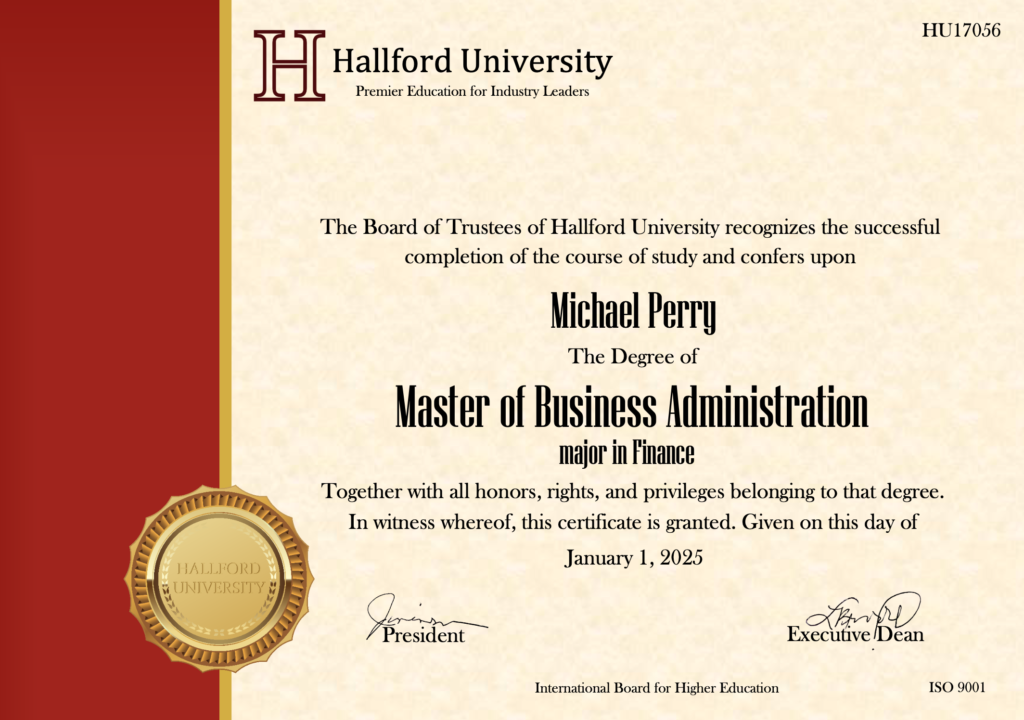MBA in Finance
Introduction
The MBA in Finance program is a comprehensive and dynamic course designed for professionals seeking to deepen their understanding of financial principles and their application in a globalized economy.
Overview of the MBA in Finance Program
This program is tailored to equip individuals with the tools and knowledge necessary to navigate the complexities of financial management, investment strategies, and global markets. Whether you are looking to advance your career in corporate finance, investment banking, or entrepreneurship, this program provides a strong foundation.
Importance of Finance in Today’s Global Economy
In a world driven by rapid globalization and economic integration, finance plays a pivotal role in decision-making processes. From capital markets and risk management to corporate growth strategies, finance is the backbone of business operations and a critical driver of innovation and economic stability.
Key Highlights of the Program
- Online & Flexible Learning: Designed for working professionals, this program offers the flexibility to balance work, studies, and personal commitments.
- Globally Recognized Curriculum: Our MBA in Finance adheres to international standards, ensuring relevance and recognition across industries worldwide.
- Career-Focused Approach: Gain practical insights and skills that are immediately applicable, enhancing your employability and leadership potential.
Program Objectives
The MBA in Finance program is designed to provide students with a well-rounded education that focuses on both theoretical foundations and practical applications of financial principles. The program aims to achieve the following key objectives:
- Develop Financial Management Skills
Equip students with comprehensive financial management knowledge, enabling them to effectively oversee budgets, manage investments, and optimize organizational resources. - Master Financial Analysis and Decision-Making
Train students to evaluate financial data, conduct rigorous analyses, and make sound financial decisions that align with business goals. - Equip Students with Tools to Handle Complex Financial Challenges
Provide advanced tools and methodologies to address and solve intricate financial problems, including risk management, corporate restructuring, and global market dynamics. - Foster Leadership and Strategic Thinking
Cultivate leadership skills and strategic foresight, empowering students to lead financial teams, influence corporate strategy, and drive organizational success in a competitive business environment.
Who Should Enroll?
The MBA in Finance program is ideal for individuals from diverse professional and educational backgrounds who aim to excel in the financial domain. This program is tailored for:
- Professionals Aiming to Advance in Finance-Related Roles
Those looking to elevate their careers in areas such as financial planning, analysis, and management. - Graduates Seeking Expertise in Financial Management
Recent graduates who aspire to build a strong foundation and develop advanced skills in financial management. - Entrepreneurs Looking to Manage Finances Effectively
Business owners who wish to gain the knowledge and tools necessary to handle their company’s financial operations efficiently. - Individuals Aspiring to Work in Banking, Investment, or Corporate Finance
Anyone seeking to specialize in high-demand fields like banking, investment management, private equity, or corporate finance.
Curriculum Overview
The MBA in Finance program is structured to provide a deep understanding of financial concepts, tools, and strategies over a flexible 1-year duration, totaling 2,000 hours of study.
Program Duration:
- 1 Year (Flexible Learning)
- Total Hours: 2,000
Module 1: Financial Accounting and Reporting (5 weeks)
- 1.1.1. Overview of financial accounting principles and standards (e.g., GAAP, IFRS).
- 1.1.2. The role of financial accounting in business decision-making.
- 1.1.3.Basic accounting equation: Assets = Liabilities + Equity.
- 1.2.1. Structure and components of the income statement.
- 1.2.2. Revenue recognition and expense matching principles.
- 1.2.3 Calculation of net income and earnings per share (EPS).
- 1.2.4. Understanding operating vs. non-operating income.
- Module 1.3.1. Structure and components of the balance sheet (Assets, Liabilities, Equity).
- Module 1.3.2. The relationship between the balance sheet and other financial statements.
- Module 1.3.3. Understanding current vs. non-current assets and liabilities.
- Module 1.3.4. Financial ratios: liquidity ratios, solvency ratios.
- Module 1.4.1.Importance of the cash flow statement in assessing a company’s liquidity.
- Module 1.4.2. Structure and components: operating, investing, and financing activities.
- Module 1.4.3. Indirect vs. direct method of cash flow preparation.
- Module 1.4.4. How to analyze cash flow from operating activities.
- Module 1.5.1 Techniques for analyzing financial statements: trend analysis, ratio analysis, common-size analysis.
- Module 1.5.2.The significance of financial reporting for external users (investors, creditors).
- Module 1.5.3. The role of auditors and the importance of financial statement accuracy.
- Module 1.5.4. Preparing and presenting financial statements for business stakeholders.
Module 2: Corporate Finance (5 Weeks)
- Module 2.1.1.Overview of Corporate Finance
- Module 2.1.2.The role of financial managers and their responsibilities
- Module 2.1.3. Financial decision-making process: Investment, financing, and dividend decisions
- Module 2.1.4 Time value of money (TVM): Introduction to concepts of present value (PV) and future value (FV)
- Module 2.2.1. What is Capital Budgeting?
- Module 2.2.2. Methods of Investment Appraisal: Payback period, NPV, IRR, Profitability Index (PI)
- Module 2.2.3. Advantages and disadvantages of each method
- Module 2.3.1. Assessing risk in capital budgeting
- Module 2.3.2. Sensitivity Analysis: How changes in assumptions affect outcomes
- Module 2.3.3. Scenario Analysis: Evaluating best, worst, and most likely scenarios
- Module 2.3.4. Risk-adjusted discount rates
- Module 2.4.1. What is Capital Structure?
- Module 2.4.2. The trade-off theory: Balancing debt and equity
- Module 2.4.3. Modigliani and Miller Proposition (without taxes and with taxes)
- Module 2.4.4. Optimal capital structure: Factors influencing the decision
- Module 2.5.1. Financial strategy and its alignment with business goals
- Module 2.5.2. Dividend policy and its impact on capital structure
- Module 2.5.3. Mergers and acquisitions: Financing strategies and impacts on value
- Module 2.5.4. Financing decisions: Debt, equity, and hybrid instruments
Module 3: Financial Markets and Institutions (5 weeks)
- Module 3.1.1. Overview of financial markets and their role in the economy
- Module 3.1.2. Types of financial markets: Capital markets, money markets, foreign exchange markets
- Module 3.1.3. Overview of financial institutions: Commercial banks, investment banks, insurance companies, pension funds
- Module 3.1.4. The role of financial intermediaries in the economy
- Module 3.2.1. Key financial instruments: Stocks, bonds, derivatives, and currencies
- Module 3.2.2. The role of investors: Individual investors, institutional investors, and foreign investors
- Module 3.2.3. Market participants: Market makers, brokers, and regulators
- Module 3.2.4. The concept of market liquidity and price discovery
- Module 3.3.1. Overview of monetary policy: Tools and objectives
- Module 3.3.2. The role of central banks: The Federal Reserve, ECB, and other central banks
- Module 3.3.3. The impact of interest rates and money supply on financial markets
- Module 3.3.4. Quantitative easing and its effects on financial markets and institutions
- Module 3.4.1. Structure and functions of commercial and investment banks
- Module 3.4.2. The role of non-banking financial institutions (NBFIs) like insurance companies, pension funds, and microfinance institutions
- Module 3.4.3. Financial regulation and its impact on financial institutions
- Module 3.4.4. Systemic risk and the role of regulators in maintaining financial stability
- Module 3.5.1. How financial markets facilitate economic growth
- Module 3.5.2. The impact of capital flows: Foreign Direct Investment (FDI) and portfolio investment
- Module 3.5.3. The role of financial markets in corporate governance and sustainability
- Module 3.5.4. Globalization of financial markets and challenges faced by emerging markets
Module 4: Investment Management (5 weeks)
- Module 4.1.1. Overview of investment management and its role in the financial system
- Module 4.1.2. Types of investments: Equities, fixed income, real estate, commodities, and alternative investments
- Module 4.1.3. The relationship between risk and return in investment decisions
- Module 4.1.4. The importance of investment objectives and constraints in portfolio management
- Module 4.2.1. Modern portfolio theory (MPT) and the efficient frontier
- Module 4.2.2. The Capital Asset Pricing Model (CAPM)
- Module 4.2.3. Asset allocation: Strategic vs. tactical
- Module 4.2.4. Diversification and its benefits in portfolio management
- Module 4.3.1. Stock selection and fundamental analysis
- Module 4.3.2. Technical analysis and charting techniques
- Module 4.3.3. Growth vs. value investing
- Module 4.3.4. Passive vs. active investment strategies in equities
- Module 4.4.1. Bond valuation and yield curves
- Module 4.4.2. Different types of bonds: Government, corporate, municipal, and high-yield
- Module 4.4.3. Duration and interest rate risk in bond investing
- Module 4.4.4. Building a bond portfolio: Laddering, barbell, and bullet strategies
- Module 4.5.1. Overview of alternative investments: Real estate, commodities, hedge funds, private equity
- Module 4.5.2. The role of alternative investments in portfolio diversification
- Module 4.5.3. Measuring portfolio performance: Sharpe ratio, alpha, and beta
- Module 4.5.4. Adjusting portfolio strategies based on performance metrics
Module 5: Advanced Financial Modeling (4 weeks)
- Module 5.1.1. Overview of financial modeling: What it is and its importance in financial analysis and decision-making.
- Module 5.1.2. Basic functions and formulas in Excel for financial modeling (SUM, AVERAGE, IF, VLOOKUP, etc.).
- Module 5.1.3. Understanding data organization: Creating clean, organized spreadsheets.
- Module 5.1.4. Structuring a basic financial model: Inputs, assumptions, calculations, and outputs.
- Module 5.2.1. Building forecasting models: Projecting financial statements (income statement, balance sheet, cash flow statement).
- Module 5.2.2. Creating assumptions for revenue, expenses, and growth.
- Module 5.2.3. Developing budgeting models for business planning: Fixed vs. variable costs, CAPEX, and OPEX.
- Module 5.2.4. Sensitivity analysis: Analyzing the impact of changes in assumptions.
- Module 5.3.1. Introduction to valuation modeling: Discounted Cash Flow (DCF), Comparable Companies, and Precedent Transactions.
- Module 5.3.2. Building a DCF model in Excel: Free cash flow projections, calculating terminal value, and discount rates.
- Module 5.3.3. Relative valuation methods: Using multiples (P/E, EV/EBITDA) to value a company.
- Module 5.3.4. Leveraging Excel tools to automate valuation processes.
- Module 5.4.1. Integrating financial models: Combining forecasting, budgeting, and valuation models into one dynamic model.
- Module 5.4.2. Advanced Excel functions for financial modeling: Pivot tables, data tables, scenario analysis, and macros.
- Module 5.4.3. Building interactive dashboards and reports for management and stakeholders.
- Module 5.4.4. Final project: Building a comprehensive financial model that integrates all learned concepts.
Module 6: International Finance (4 Weeks)
- Module 6.1.1. Overview of international finance: The global financial system and its components.
- Module 6.1.2. Introduction to foreign exchange (FX) markets: How currency markets work and the role of central banks.
- Module 6.1.3. Key players in FX markets: Governments, multinational corporations, banks, and speculators.
- Module 6.1.4. Understanding exchange rates: Determinants of exchange rates, types of exchange rate systems (fixed vs. floating).
- Module 6.2.1. Currency risk: Definition and types of risks (transaction, translation, and economic exposure).
- Module 6.2.2. Managing currency risk: Techniques for hedging currency risk (forward contracts, options, and swaps).
- Module 6.2.3. Hedging strategies for multinational corporations: Risk management in global business operations.
- Module 6.2.4. Case study: Currency risk management strategies used by global companies.
- Module 6.3.1. Understanding global capital markets: The role of international bond and equity markets in global finance.
- Module 6.3.2. Capital flows and foreign investment: Types of cross-border investments and their risks.
- Module 6.3.3. International capital budgeting: Evaluating projects with foreign investment considerations (exchange rate risks, country risk).
- Module 6.3.4. Impact of monetary and fiscal policies on international finance: How central bank policies and government fiscal decisions affect global finance.
- Module 6.4.1. The role of international banking in global finance: Functions of banks in cross-border trade and investment.
- Module 6.4.2. Trade finance: Understanding letters of credit, trade credit, and the financing of international trade transactions.
- Module 6.4.3. Global financial regulations: How regulatory environments in different countries affect international finance.
- Module 6.4.4. Challenges in cross-border finance: Managing political, economic, and legal risks in global markets.
Module 7: Risk Management and Derivatives (5 Weeks)
- Module 7.1.1. Understanding financial risk: Types of financial risk (market risk, credit risk, liquidity risk, operational risk).
- Module 7.1.2. The importance of risk management in finance: Protecting capital and ensuring stability in uncertain markets.
- Module 7.1.3. Risk identification and assessment: Techniques for identifying and measuring risk in financial portfolios.
- Module 7.2.1. What are derivatives? An introduction to derivative contracts.
- Module 7.2.2. Types of derivatives: Futures, forwards, options, and swaps.
- Module 7.2.3. How derivatives work: Basic principles of trading and settlement.
- Module 7.3.1. Understanding options: Call options, put options, and their uses.
- Module 7.3.2. Option pricing models: Black-Scholes model and factors affecting option prices (e.g., volatility, time decay).
- Module 7.3.3. Strategies for using options in risk management: Hedging with options, speculative use, and protective puts.
- Module 7.4.1. Futures contracts: Understanding the mechanics, margin requirements, and settlement of futures.
- Module 7.4.2. How futures contracts are used for hedging: Hedging with futures in commodities, currencies, and financial instruments.
- Module 7.4.3. Swaps: Interest rate swaps, currency swaps, and commodity swaps. How swaps are used in risk management.
- Module 7.5.1. Advanced risk management strategies: Dynamic hedging, diversification, and using derivatives for portfolio protection.
- Module 7.5.2. Regulatory considerations in derivatives trading: Understanding the impact of financial regulations (e.g., Dodd-Frank Act, EMIR).
- Module 7.5.3. Real-world applications: How financial institutions, corporations, and investors use derivatives and risk management techniques in practice.
Module 8: Mergers, Acquisitions, and Corporate Restructuring (5 Weeks)
- Module 8.1.1. Overview of mergers, acquisitions, and corporate restructuring.
- Module 8.1.2. Reasons for M&A: Strategic motives, growth, market expansion, synergy.
- Module 8.1.3. Types of M&A transactions: Horizontal, vertical, and conglomerate mergers.
- Module 8.2.1. Common valuation methods used in M&A: Discounted Cash Flow (DCF), Comparable Company Analysis (CCA), Precedent Transactions Analysis (PTA).
- Module 8.2.2. Understanding how to calculate a company’s value in an M&A transaction.
- Module 8.2.3. Assessing financial performance and forecasting future cash flows.
- Module 8.3.1. Deal structures: Asset purchase vs. stock/share purchase.
- Module 8.3.2. Financing M&A deals: Debt, equity, and hybrid financing options.
- Module 8.3.3. Due diligence process: Financial, operational, and legal considerations.
- Module 8.4.1. Strategies for integrating merged companies: Cultural, operational, and strategic considerations.
- Module 8.4.2. Measuring the success of M&A transactions: Post-merger performance analysis.
- Module 8.4.3. Challenges in post-merger integration: Managing change, aligning corporate cultures, and realizing synergies.
- Module 8.5.1. Corporate restructuring: Types of restructuring (financial, operational, divestitures).
- Module 8.5.2. Leveraged buyouts (LBOs): Definition, structure, and key considerations.
- Module 8.5.3. Financial modeling for LBOs and restructuring: Techniques for assessing the viability of LBOs and restructuring deals.
Module 9: Financial Planning and Analysis (4 weeks)
- Module 9.1.1. Overview of financial planning and analysis (FP&A).
- Module 9.1.2. The role of financial forecasting in business planning.
- Module 9.1.3. Methods of forecasting: qualitative and quantitative techniques.
- Module 9.1.4. Developing financial models for forecasting.
- Module 9.2.1. Overview of budgeting: Types of budgets (operating, capital, cash flow).
- Module 9.2.2. The budgeting process: Steps and considerations for effective budgeting.
- Module 9.2.3. Resource allocation: Prioritizing investments and expenses to align with organizational goals.
- Module 9.3.1. Key performance indicators (KPIs) for financial performance.
- Module 9.3.2. Financial metrics: ROI, ROA, ROE, profit margins, and others.
- Module 9.3.3. Using financial metrics to evaluate the effectiveness of budgeting and forecasting.
- Module 9.4.1. Financial planning for scaling and growth.
- Module 9.4.2. Strategic financial planning: Aligning financial goals with business objectives.
- Module 9.4.3. Creating a financial plan for expansion: Forecasting revenue, managing expenses, and securing financing.
Module 10: Ethics and Corporate Governance in Finance(4 weeks)
- Module 10.1.1. Definition of ethics in finance.
- Module 10.1.2. Ethical decision-making frameworks in financial management.
- Module 10.1.3. Ethical dilemmas in financial practices (e.g., insider trading, conflicts of interest, financial fraud).
- Module 10.1.4. The role of financial professionals in maintaining ethical standards.
- Module 10.2.1. The concept of corporate governance and its importance in financial management.
- Module 10.2.2. Key principles of corporate governance (e.g., transparency, accountability, fairness).
- Module 10.2.3. Roles of board members, executives, and shareholders in governance.
- Module 10.2.4. The relationship between corporate governance and company performance.
- Module 10.3.1. Overview of financial regulations (e.g., Sarbanes-Oxley Act, Dodd-Frank Act, Basel III).
- Module 10.3.2. The role of regulatory bodies (e.g., SEC, FCA, FINRA).
- Module 10.3.3. Importance of compliance in financial operations.
- Module 10.3.4. Consequences of non-compliance (e.g., fines, legal consequences, reputational damage).
- Module 10.4.1. Ethical considerations in sustainable finance and socially responsible investing (SRI).
- Module 10.4.2. The role of environmental, social, and governance (ESG) factors in financial decision-making.
- Module 10.4.3. Corporate social responsibility (CSR) and its financial implications.
- Module 10.4.4. Integrating ethics and governance into financial strategy for long-term value creation.
Module 11: Behavioral Finance ( 4 weeks)
- Module 11.1.1. Definition of behavioral finance and its distinction from traditional finance.
- Module 11.1.2. Key concepts in behavioral finance (e.g., bounded rationality, prospect theory).
- Module 11.1.3. The role of psychological factors in financial decision-making.
- Module 11.1.4.Common biases affecting investment decisions (e.g., overconfidence, loss aversion).
- Module 11.2.1. Common cognitive biases influencing financial decision-making (e.g., anchoring, confirmation bias, availability bias).
- Module 11.2.2. The impact of biases on stock prices, trading volume, and market trends.
- Module 11.2.3. Case studies of real-world examples of cognitive biases in the financial markets.
- Module 11.3.1. The role of emotions in financial decision-making (e.g., fear, greed, and overconfidence).
- Module 11.3.2. How emotional responses lead to market anomalies (e.g., bubbles, crashes).
- Module 11.3.3. The influence of social factors on investment behavior (e.g., herd mentality, social contagion).
- Module 11.3.4. The relationship between investor sentiment and market trends.
- Module 11.4.1. Overview of market anomalies and the efficient market hypothesis (EMH).
- Module 11.4.2. Examples of common market anomalies (e.g., the January effect, momentum effect, value vs. growth stocks).
- Module 11.4.3. Behavioral strategies to mitigate the impact of biases on investment decisions.
- Module 11.4.4. The role of behavioral finance in portfolio management and asset pricing.
Career Options After Graduation
An MBA in Finance opens doors to a world of opportunities across diverse industries. Graduates are equipped with the skills and expertise to excel in roles requiring financial acumen, strategic thinking, and leadership. Here are some prominent career paths you can pursue:
Corporate Finance
- Financial Analyst
- Budget Manager
- Treasury Specialist
- Chief Financial Officer (CFO)
Investment Banking
- Mergers & Acquisitions Analyst
- Equity Research Associate
- Debt Capital Markets Specialist
Financial Planning and Analysis (FP&A)
- Financial Planner
- Corporate Strategy Consultant
- Business Development Analyst
Wealth Management and Advisory
- Portfolio Manager
- Private Wealth Advisor
- Investment Strategist
Risk Management
- Risk Analyst
- Credit Risk Manager
- Compliance Officer
Consulting
- Financial Consultant
- Management Consultant
- Business Transformation Specialist
Asset Management
- Fund Manager
- Real Estate Investment Analyst
- Hedge Fund Analyst
FinTech and Startups
- Financial Product Manager
- FinTech Strategy Analyst
- Venture Capital Associate
Global Opportunities
With a strong foundation in finance and a global perspective, graduates can work in multinational corporations, international banks, or pursue entrepreneurial ventures.
Total Program Cost
$550
Cost Breakdown
| Description | Amount |
|---|---|
| Application Fee | $55 |
| Tuition Fee | $0 |
| Degree Certificate | $55 |
| Transcripts | $55 |
| Miscellaneous, Technology, & Other Fees | $385 |
| Total Cost | $550 |
Flexible Payment Options
- One-Time Payment: Pay the full program cost upfront.
- Monthly Payment Plan: $55 per month for 12 months, including interest.
Invest in your education with transparent and flexible payment options tailored to your needs.

HEAR FROM OUR STUDENTS
ACCREDITATIONS

At Hallford University, we’re thrilled to share that we are an ISO 9001: 2015 certified organization and accredited by the International Board for Higher Education. These recognitions is like a badge of honor for us, and it signifies our deep commitment to providing top-notch education.
You might be wondering, what does accreditation really mean? Well, it’s like a seal of approval from experts in the field of education. They’ve taken a close look at our programs, our faculty, and our overall operations, and they’ve given us a big thumbs-up. It’s a way of saying that we’re doing things the right way and maintaining high standards.
This accreditation isn’t just a piece of paper; it’s a reflection of the hard work and dedication of our entire team, from our educators to our support staff. We’re all in this together, with one goal in mind: to provide you, our students, with an outstanding education.

IBHE Certificate of Accredition
What it means for you is that when you choose Hallford University, you’re choosing an institution that’s been recognized for its commitment to quality. You can trust that the education you receive here meets or even exceeds the standards set by experts in the field.
So, when you embark on your educational journey with us, know that you’re not just enrolling in a university; you’re joining a community of learners dedicated to helping you achieve your academic and professional goals. We’re here to support you every step of the way, and our accreditation is a testament to our promise of delivering a world-class education to learners from all walks of life.
learn more
-
Is an Online MBA Worth It in 2025? Real ROI, Salary & Career Data
Introduction: The MBA Dilemma in 2025 Let’s cut to the chase.In 2025, business professionals are standing at a crossroads.On one side: inflation, AI-driven job shifts, and a competitive global market.On the other: the promise of an Online MBA , flexible, remote, and career-boosting… supposedly. But is it actually worth it?Or just another expensive piece of…
-
Is an Online DBA Worth It? Here’s What You Need to Know
If you’re a business professional looking to advance your career, specialize in executive leadership, or transition into consulting or academia, pursuing an online Doctor of Business Administration (DBA) could be a game-changing move. But with so many options and opinions out there, one big question remains: Is an online DBA degree really worth it? Let’s…
-
The Importance of Lifelong Learning: Continuing Education at Hallford University
In today’s fast-paced, ever-changing world, one thing is clear: learning never stops. No matter your career stage or field of expertise, staying current with new skills, trends, and technologies is crucial to both personal and professional growth. At Hallford University, we believe in the power of lifelong learning, which is why we offer a wide range of continuing…
-
The Future of Online Education: What to Expect in the Next 5 Years
The Future of Online Education: What to Expect in the Next 5 Years Online education has evolved rapidly over the last decade, transforming the way people access learning opportunities. What was once seen as a secondary option is now a dominant force in the education landscape. As technology continues to advance, the future of online…
-
Making a Difference: How Businesses Can Champion Environmental Responsibility
Welcome to ‘Making a Difference: How Businesses Can Champion Environmental Responsibility.’ In this insightful guide, we embark on a journey to explore the pivotal role of businesses in shaping a sustainable future. From innovative practices to impactful strategies, we uncover how businesses can become champions of environmental responsibility, driving positive change and leaving a lasting…
-
Boost Your Resume: Elevate Your Career with an Online DBA/MBA
Are you looking to take your career to new heights? Have you considered the transformative power of earning an online DBA or MBA? In today’s competitive job market, having an advanced degree can make all the difference in propelling your career forward. Let’s explore how pursuing an online DBA or MBA can significantly boost your…











